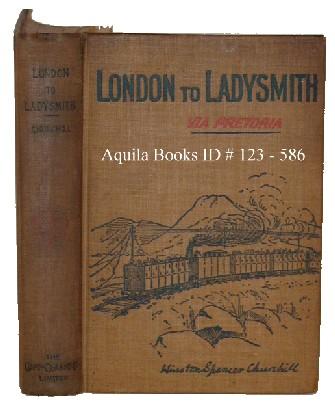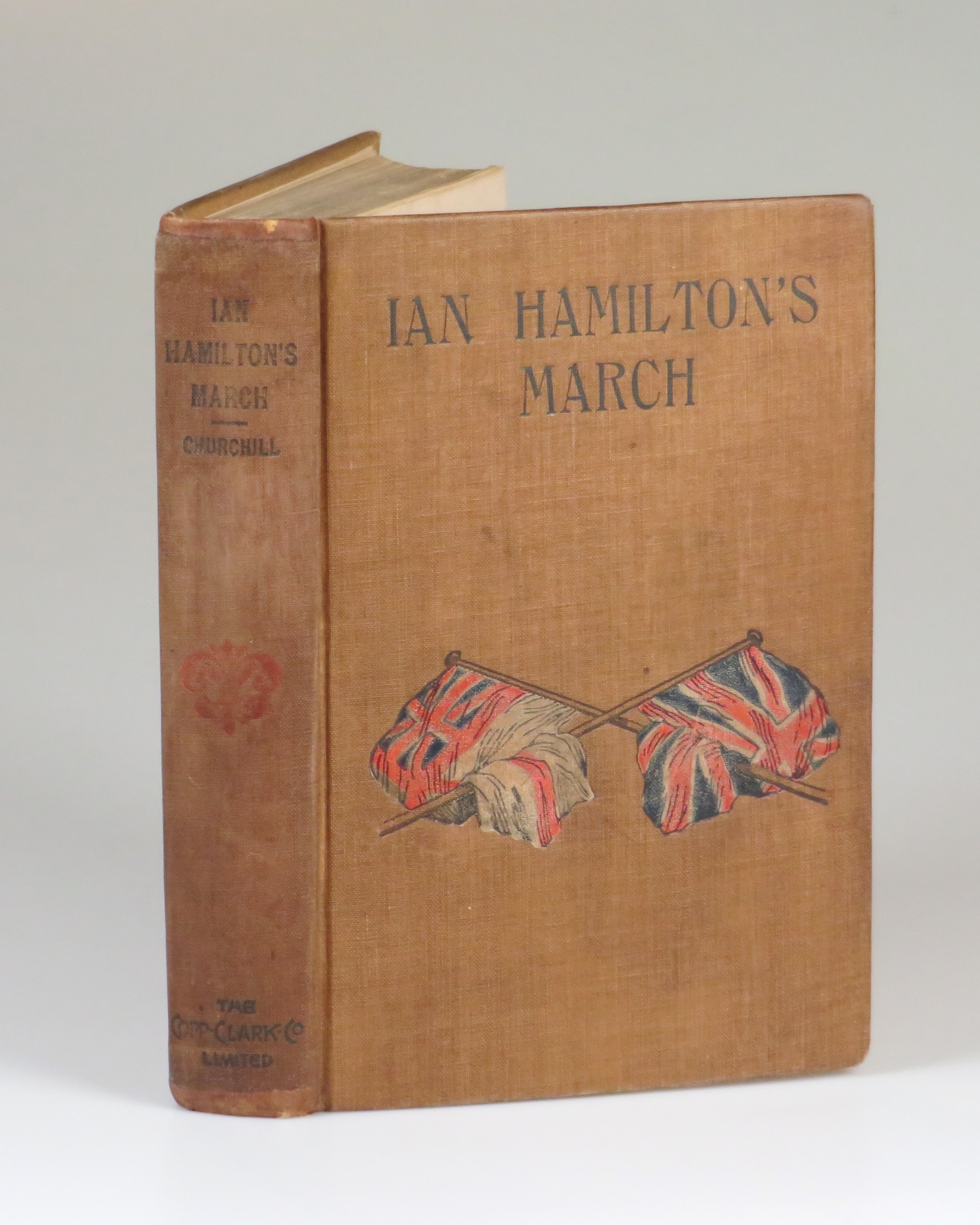Available Copies from Independent Booksellers

Price: US$200.00 + shipping
Description: This is the Canadian first edition of Churchill's fourth published book. Both U.S. and Canadian editions were published in June 1900. The Canadian is the scarcest of the three English-language first editions. This Canadian edition was bound in tan cloth with an illustrated front cover like its British counterpart, and is easily distinguishable by a red fleur-de-lis on the spine, thinner binding, and black title and author print. The attractive binding is prone to both hinge breaks and severe spine toning. Here is a respectable and sound ex-library copy. The binding is clean, tight, and square, with only modest shelf wear to extremities and mild spine toning. Nonetheless, there is a whitish rectangle below the author's name on the spine, ostensibly from removal of a library label, library number stamps on both pastedowns, the half title, and the title page, scarring from library pocket removal on the rear pastedown and facing final free endpaper verso, and the front free endpaper has been excised, only the stub remaining. A previous owner name and date of "Xmas 1901" is written in pencil on the lower half title recto. Apart from the ex-library marks, the contents are notably clean, with no spotting, intact maps, and modest soiling and toning confined to the page edges.London to Ladysmith via Pretoria is the first of Churchill's two books based on his newspaper despatches sent from the front in South Africa. In October 1899, the second Boer War erupted between the descendants of Dutch settlers in South Africa and the British. Churchill, an itinerant, adventure-seeking young cavalry officer and war correspondent, swiftly found himself in South Africa with the 21st Lancers and an assignment as press correspondent to the Morning Post. Not long thereafter, on 15 November 1899, Churchill was captured during a Boer ambush of an armored train. His daring and dramatic escape less than a month later made him a celebrity and helped launch his political career.London to Ladysmith via Pretoria contains 27 letters and telegrams to the Morning Post written between 26 October 1899 and 10 March 1900. It was published in England in mid-May 1900 and sold well. Churchill returned from South Africa in July 1900 and spent the summer campaigning hard in Oldham. Churchill had lost the Oldham by-election his first attempt at Parliament in July 1899. Since then, as Arthur Balfour (who became Prime Minister in 1902) put it in a 30 August 1900 letter, the young Churchill had had "fresh opportunities - admirably taken advantage of for shewing the public of what stuff you are made." Indeed; Churchill won his first seat in Parliament on 1 October 1900 in the so-called "khaki election".Reference: Cohen A4.3.a, Woods/ICS A4(bb), Langworth p.56.
Seller: Churchill Book Collector ABAA/ILAB/IOBA, San Diego, CA, U.S.A.

Price: US$356.99 + shipping
Condition: Very Good
Description: 1st Canadian Edition. xi,1l.,496 pp.pp. Sm. Octavo. Three folding maps (including frontispiece) and illustrations (maps and plans) in original decorated brown cloth. Spine somewhat darkened. Text is very clean with no internal problems. Boards a little soiled but overall a very presentable copy. very good Woods A4 (1ST English Edition). A personal record of the author's experiences in the first five months of the African war originally published in the 'Morning Post'. Scarcer than the U.K or U.S. Editions.
Seller: Aquila Books(Cameron Treleaven) ABAC, Calgary, AB, Canada

Price: US$483.13 + shipping
Description: This is a scarce book in quite nice condition but does have some soiling to the covers and a small fore edge stain. The front free end paper has a Xmas gifting dated 1900. The three fold out maps are intact and in nice condition. 496pp
Seller: G W Jackson, St.Marys, ON, Canada

Winston S. Churchill. Ian Hamilton's March. The Copp, Clark Company, Ltd., Toronto, 1900.
Price: US$500.00 + shipping
Description: This is the scarce Canadian first edition of Churchill's fifth book. Ian Hamilton's March was the second of Churchill's two books based on his newspaper dispatches sent from the front in South Africa during the Boer War. During this conflict Churchill was captured by the Boers. His daring escape made him a celebrity and helped launch his political career.There were three English-language editions British, U.S. and Canadian. The U.S. and Canadian editions were published in November 1900. The Canadian is both the scarcest and most attractive of the three first editions, differing considerably in appearance from its British and U.S. counterparts, with a tan cloth binding illustrated with crossed Union Flag and White Ensign on the front cover and a red fleur-de-lis on the spine. The Canadian first editions seem particularly vulnerable to gutter breaks. They are also prone to severe spine toning. This copy is good, sound and complete though with aesthetic defects. The binding is tight with no sign of the typical gutter breaks. The front cover, with its striking crossed flags illustration, remains respectably bright, with only minor soiling and toning. The spine is toned and wrinkled with discreet brown cloth reinforcement at the head and tail. The red fleur-de-lis dulled but still visible. The rear cover is lightly scuffed and soiled. The contents are respectably bright and clean. Modest age-toning is evident only on the page edges. Spotting is quite light. We find no previous ownership marks. All maps and plans are present, including the folding map at p.408, as is the frontispiece portrait.Ian Hamilton's March completes Churchill's coverage of the Boer War, publishing 17 letters to the Morning Post, spanning 31 March through 14 June 1900. (Cohen, A8.1.a, Vol. I, p.105) The narrative in Ian Hamilton's March includes the liberation of the Pretoria prison camp where Churchill had been held. The title takes its name from General Sir Ian Hamilton's campaign from Bloemfontein to Johannesburg and Pretoria. Churchill would maintain a life-long friendship with Hamilton, who would be involved in the First World War Gallipoli landings and to whom Churchill would sell his first country home. Ian Hamilton's March was first published in England in October, just a few weeks after Churchill's first election to Parliament. This Canadian edition followed no later than mid-November. Though a companion and sequel to London to Ladysmith, it differs in important respects. While London to Ladysmith via Pretoria had swiftly published Churchill's dispatches in the wake of his capture and escape, for Ian Hamilton's March "the texts of the originally published letters were more extensively revised and four letters were included which had never appeared in periodical form" (Cohen). Churchill effected these revisions while on board the passenger and cargo steamer Dunottar Castle (requisitioned as a troop ship) en route home to England. Churchill arrived on 20 July 1900 and spent the summer campaigning hard in Oldham, capitalizing on his war status and winning his first seat in Parliament on 1 October 1900 in the so-called "khaki election." Reference: Cohen A8.3, Woods/ICS A5(cb), Langworth p.61
Seller: Churchill Book Collector ABAA/ILAB/IOBA, San Diego, CA, U.S.A.

Winston S. Churchill. Ian Hamilton's March. The Copp, Clark Company, Ltd., Toronto, 1900.
Price: US$500.00 + shipping
Description: This is the scarce Canadian first edition of Churchill's fifth book. Ian Hamilton's March was the second of Churchill's two books based on his newspaper dispatches sent from the front in South Africa during the Boer War. During this conflict Churchill was captured by the Boers. His daring escape made him a celebrity and helped launch his political career.There were three English-language editions British, U.S. and Canadian. The U.S. and Canadian editions were published in November 1900. The Canadian is both the scarcest and most attractive of the three first editions, differing considerably in appearance from its British and U.S. counterparts, with a tan cloth binding illustrated with crossed Union Flag and White Ensign on the front cover and a red fleur-de-lis on the spine. The Canadian first editions seem particularly vulnerable to gutter breaks. They are also prone to severe spine toning. This copy is complete and unrestored, though with aesthetic defects. The binding is tight with sharp corners and no sign of the typical gutter breaks. The front cover, with its striking crossed flags illustration, remains bright with only slight mottling near the upper fore edge. The spine is toned and soiled, the red fleur-de-lis dulled but still visible. The chief detraction of this copy is significant mottling to roughly two-thirds of the rear cover. It seems likely that the book was once placed on a slightly damp surface. Though unattractive, this defect poses no threat to binding integrity. The contents are respectably bright and clean. Modest age-toning is evident only on the page edges. Trivial spotting appears substantially confined to the rear pastedown. The sole previous ownership mark is an ink-stamped "THE PROPERTY OF | S. FRANK WILSON." and an ink-stamped personal library number "40" on the front pastedown. The fore and bottom edges are lightly soiled, the top edge dusty.Ian Hamilton's March completes Churchill's coverage of the Boer War, publishing 17 letters to the Morning Post, spanning 31 March through 14 June 1900. (Cohen, A8.1.a, Vol. I, p.105) The narrative in Ian Hamilton's March includes the liberation of the Pretoria prison camp where Churchill had been held. The title takes its name from General Sir Ian Hamilton's campaign from Bloemfontein to Johannesburg and Pretoria. Churchill would maintain a life-long friendship with Hamilton, who would be involved in the First World War Gallipoli landings and to whom Churchill would sell his first country home. Ian Hamilton's March was first published in England in October, just a few weeks after Churchill's first election to Parliament. This Canadian edition followed no later than mid-November. Though a companion and sequel to London to Ladysmith, it differs in important respects. While London to Ladysmith via Pretoria had swiftly published Churchill's dispatches in the wake of his capture and escape, for Ian Hamilton's March "the texts of the originally published letters were more extensively revised and four letters were included which had never appeared in periodical form" (Cohen). Churchill effected these revisions while on board the passenger and cargo steamer Dunottar Castle (requisitioned as a troop ship) en route home to England. Churchill arrived on 20 July 1900 and spent the summer campaigning hard in Oldham, capitalizing on his war status and winning his first seat in Parliament on 1 October 1900 in the so-called "khaki election." Reference: Cohen A8.3, Woods/ICS A5(cb), Langworth p.61
Seller: Churchill Book Collector ABAA/ILAB/IOBA, San Diego, CA, U.S.A.

Churchill, Winston S.. London to Ladysmith Via Pretoria. Copp, Clark, 1900.
Price: US$624.00 + shipping
Condition: Very Good
Description: Cannot authenticate signature. x-lib. slight cover lean. sticker residue and minor white out on spine. one bumped corner; map is black and white with colour lines and library taped to the inside blank front page; library stamp on first page and on inside front cover; pages are intact in this century old book
Seller: Booksdoc, Russell, ON, Canada

Price: US$641.63 + shipping
Description: First Canadian edition, first printing, cloth issue, of Churchill's account of his experiences as a war correspondent in the Second Boer War. This copy is from the collection of Churchill's bibliographer Ronald Cohen. "The volume essentially consists of 27 letters and telegrams to the Morning Post written between 26 October 1899 and 10 March 1900. It is, as Churchill said in his Introductory Note, 'mainly a personal record of my adventures and impressions during the first five months of the African War. It may also be found to give a tolerably coherent account of the operations conducted by Sir Redvers Buller for the Relief of Ladysmith" (Cohen). A major component is Churchill's internment in a prisoner-of-war camp and his daring escape, which enthralled readers at the time and helped to cement his reputation as a man of action and character. The Canadian edition was issued from the plates of the US edition, both published in June 1900, following the British edition in May. The Canadian is "the scarcest by far of the three first editions" (Langworth, p. 56). It was also issued in wrappers, though almost never surviving in that format. Provenance: Ronald Cohen, with his ownership inscription in pencil on the front free endpaper. Cohen's Bibliography of the Writings of Sir Winston Churchill, published in three volumes in 2006, is the authoritative source for collectors, librarians, and dealers. Cohen A4.3.a. Richard Langworth, A Connoisseur's Guide to the Books of Sir Winston Churchill, 1998. Octavo. Original brown cloth, spine lettered in red and black, front cover lettered in red and black with black line-drawing of armoured train. With 3 folding maps including frontispiece, plans in text. Light spotting to cloth and edges. A near-fine copy.
Seller: Peter Harrington. ABA/ ILAB., London, United Kingdom

Price: US$650.00 + shipping
Description: This is a collector-worthy Canadian first edition of Churchill's fourth published book. Both U.S. and Canadian editions were published in June 1900. The Canadian is the scarcest of the three English-language first editions. This Canadian edition was bound in tan cloth with an illustrated front cover like its British counterpart, and is easily distinguishable by a red fleur-de-lis on the spine, thinner binding, and black title and author print. The attractive binding is prone to both hinge breaks and severe spine toning. Here is a superior example, in better than very good plus condition. The binding remains tight and square, with sharp corners. There is almost no reportable wear, with only trivial wrinkling at the spine ends. We would grade this copy as near fine with no qualifiers were it not for some of the customary spine toning endemic to this edition. Nonetheless, shelf presentation is quite respectable, the spine color even and the red fleur-de-lis still clearly legible. The contents are likewise in superior condition. We find no spotting and modest age-toning shows appreciably only on the page edges. There are three previous ownership marks: an attractive illustrated bookplate affixed to the front pastedown; an inked name on the upper front free endpaper recto; and a third name and date of "1900 June" - presumably that of the original owner inked on the upper title page. The ink of this original owners name has spread with time.London to Ladysmith via Pretoria is the first of Churchill's two books based on his newspaper despatches sent from the front in South Africa. In October 1899, the second Boer War erupted between the descendants of Dutch settlers in South Africa and the British. Churchill, an itinerant, adventure-seeking young cavalry officer and war correspondent, swiftly found himself in South Africa with the 21st Lancers and an assignment as press correspondent to the Morning Post. Not long thereafter, on 15 November 1899, Churchill was captured during a Boer ambush of an armored train. His daring and dramatic escape less than a month later made him a celebrity and helped launch his political career.London to Ladysmith via Pretoria contains 27 letters and telegrams to the Morning Post written between 26 October 1899 and 10 March 1900. It was published in England in mid-May 1900 and sold well. Churchill returned from South Africa in July 1900 and spent the summer campaigning hard in Oldham. Churchill had lost the Oldham by-election his first attempt at Parliament in July 1899. Since then, as Arthur Balfour (who became Prime Minister in 1902) put it in a 30 August 1900 letter, the young Churchill had had "fresh opportunities - admirably taken advantage of for shewing the public of what stuff you are made." Indeed; Churchill won his first seat in Parliament on 1 October 1900 in the so-called "khaki election".Reference: Cohen A4.3.a, Woods/ICS A4(bb), Langworth p.56.
Seller: Churchill Book Collector ABAA/ILAB/IOBA, San Diego, CA, U.S.A.